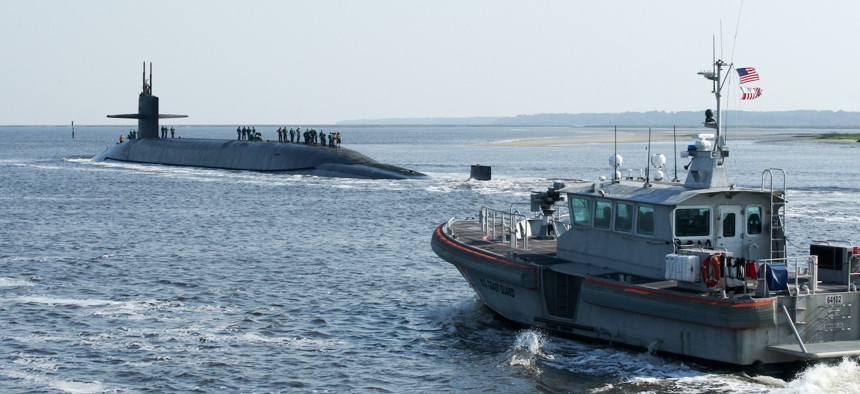
A U.S Coast Guard patrol boat, right, escorts the ballistic missile submarine USS Alaska (SSBN 732) as the submarine returns to Naval Submarine Base Kings Bay, Ga., May 22, 2014. U.S. Navy / Mass Communication Specialist 1st Class Rex Nelson
A Handful of Ohio Subs Could Get Yet Another Service Life Extension
The move would give the Navy more available SSBNs during its transition to the Columbia class.
The USS Alaska would be the first of as many as five Ohio-class ballistic missile submarines to have its service life extended if the Navy decides it’s needed during the transition to the new Columbia-class subs in the 2030s, naval officials said Tuesday.
If needed, the Alaska would get an 18-month overhaul—dubbed a pre-inactivation restricted availability, or PIRA—in 2029, when the sub would have 43 years of service, Rear Adm. Doug Perry, the director of undersea warfare, said during the annual Naval Submarine League symposium in Arlington, Virginia. The work would extend the sub's service life by three years.
The Ohios were designed in the 1970s to serve for 30 years, but upgrades and modifications have stretched their planned service lives to 42 years. Five of the 14 remaining Ohio SSBNs will have exceeded even that total when the first of the planned 12 Columbia-class subs begin deterrence patrols in 2030. Already, the current 30-year shipbuilding plan projects just 11 active SSBNs from 2030 to 2032. Extending the lives of some Ohios could give the Navy some wiggle room in the 2030s, during what Rear Adm. Scott Pappano called the “riskiest period” of the transition.
“As a submariner, we want to prepare for the worst, right? So, if something bad happens, you know, untoward incident, could be a collision at sea or whatever else, it's just hedging against that margin for one,” Pappano, the program executive officer for strategic submarines, told reporters at the symposium.
During the transition, the Columbia-class subs will begin to receive new missiles, called the Trident II D5 Life Extension 2, starting with the ninth hull, Pappano said. “And then at [the 2036 to 2039] timeframe, we have to be able to test that missile from both Ohio-class and Columbia-class submarines, right?”
That testing will “take a ship off the firing line,” he said, so the Navy will need more than 10 or 11 total ballistic missile submarines. The service will likely need at least two or three refurbished Ohio submarines during the transition, but will plan for five, he said.
The Navy still must evaluate the cost of the 18-month PIRA, but Pappano said he doesn’t believe it will be “cost-prohibitive.”
Pappano said he’ll have to decide by 2026 so the material and shipyards will be ready by 2029 for the Alaska.




